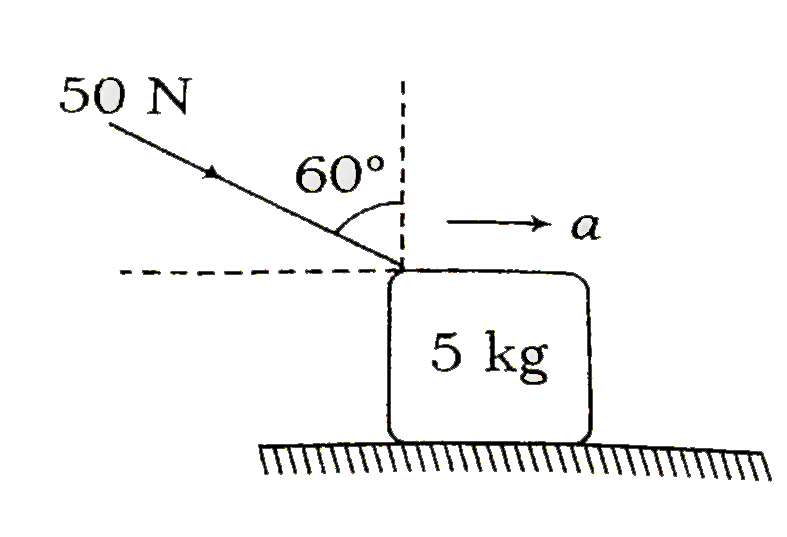A horizantal force ''F'' produces an acceleration of 6m/s2 on a block resting on a smooth horizantal surface. The same force produces an acceleration of 3m/s2 on a second block resting on a smooth horizantal surface. If the two blocks are tied together and the same force acts, the acceleration produced will be
9m/s2
2m/s2
4m/s2
1/2m/s2
The correct Answer is:B
To solve the problem, we need to find the acceleration produced when two blocks are tied together and the same force F is applied to them. Let's break it down step by step.
Step 1: Determine the mass of each block
1. For the first block, the force F produces an acceleration of 6m/s2.
- Using Newton's second law, F=m1⋅a1, we can express the mass of the first block (m1):
m1=Fa1=F6
2. For the second block, the same force F produces an acceleration of 3m/s2.
- Similarly, we can express the mass of the second block (m2):
m2=Fa2=F3
Step 2: Find the total mass when both blocks are tied together
- The total mass m of the system when both blocks are tied together is the sum of their individual masses:
m=m1+m2=F6+F3
Step 3: Simplify the total mass
- To add the two fractions, we need a common denominator:
m=F6+2F6=3F6=F2
Step 4: Calculate the acceleration of the combined system
- Now, we apply the same force F to the combined mass m:
F=m⋅a⟹a=Fm
Substituting m from the previous step:
a=FF2=2m/s2
Final Answer
The acceleration produced when the two blocks are tied together and the same force F acts on them is:
2m/s2
1. For the first block, the force F produces an acceleration of 6m/s2.
- Using Newton's second law, F=m1⋅a1, we can express the mass of the first block (m1):
m1=Fa1=F6
- Similarly, we can express the mass of the second block (m2):
m2=Fa2=F3
- The total mass m of the system when both blocks are tied together is the sum of their individual masses:
m=m1+m2=F6+F3
- To add the two fractions, we need a common denominator:
m=F6+2F6=3F6=F2
- Now, we apply the same force F to the combined mass m:
F=m⋅a⟹a=Fm
Substituting m from the previous step:
a=FF2=2m/s2
The acceleration produced when the two blocks are tied together and the same force F acts on them is:
2m/s2
Topper's Solved these Questions
- BOOK - NARAYNACHAPTER - CIRCULAR MOTIONEXERCISE - LEVEL II(H.W)51videos
CIRCULAR MOTION
- BOOK - NARAYNACHAPTER - CIRCULAR MOTIONEXERCISE - IIT QUES.4videos
CIRCULAR MOTION
- BOOK - NARAYNACHAPTER - CALORIMETRYEXERCISE - Level- II (H.W)11videos
CALORIMETRY
- BOOK - NARAYNACHAPTER - COLLISIONEXERCISE - Level-II (H.W)54videos
COLLISION
Similar Questions
A force produces an acceleration of 1.5m/s2 in a disk. Three such disks are tied together and the same force is applied on the combination. What will be the acceleration ?
View SolutionA constant force of 5N can produce an acceleration of 1 m/s2 on the body of mass m1and2m/s2 on the body of mass m2. If both the masses are tied together and same force is applied, then what will be the acceleration of the system?
View Solution
Knowledge Check
- Question 1 - Select One
A horizontal force ''F'' produces an acceleration of 6m/s−2 on a block resting on a smooth horizontal surface. The same force produces an acceleration of 3m/s−2 on a second block resting on a smooth horizontal surface. If the two blocks are tied together and the same force acts, the acceleration produced will be
A9m/s−2B2m/s−2C4m/s−2D12m/s−2 - Question 2 - Select One
A force produces an acceleration of a1 in a body and the same force produces an acceleration of A2, in another body. If the two bodies are combined and the same force is applied on the combination, the acceleration produced in it is
Aa1+a2Ba1+a2a1a2Ca1a2a1+a2D√a1a2 - Question 3 - Select One
A force produces an acceleration of a1 in a body and the same force produces an acceleration of a2 in another body. It the to bodies are combined and the same force is applied on the combination the acceleration produced in it is .
Aa1+a2Ba1+a2a1a2Ca1a2a1+a2D√a1a2
A force produces an acceleration 16m−2 in a mass 0.5kg and an acceleration 4ms−2 in an unknown mass when appied separately If both the masses are tied together what will be the acceleration under same force ? .
View SolutionA force F accelerates a block of mass m on horizontal surface. The coefficient of friction between the contact surface is . The acceleration of m will be -
View SolutionA force produces an acceleration of 4ms−2 in a body of mass m1 and the same force produces an acceleration of 6ms−2 in another body oa mass m2. If the same force is applied to (m1+m2), then the acceleration will be
View SolutionA force produces an acceleration of 4m/s2 in a body of m1kg in another body of mass m2kg If the same force is applied to (m1+m2) then the acceleration will be
View SolutionA force of 50N acts in the direction as shown in figure. The block of mass 5kg, resting on a smooth horizontal surface. Find out the acceleration of the block.
 View Solution
View Solution

